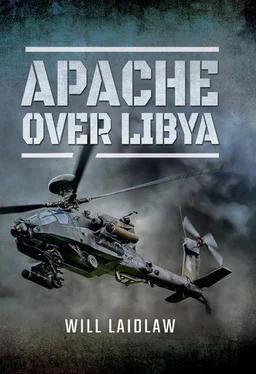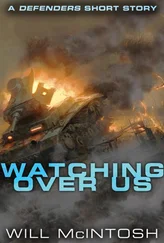I went through the airlock, turned left and stood in the engineering compartment. The Crew Chief was sitting behind the counter. He pushed the folder towards me: ‘Everything all right, Boss? Any damage?’
‘Took a bunch of triple-A and tracer was everywhere, needs a good look over. Flies nicely though, shoots straight and finds ships in the dark and everything,’ I replied and signed the aircraft into the folder. My handwriting was barely legible and I was unable to add two numbers together. My head was unable to compute the simple task of signing the aircraft in. I was full. And I was scared.
I pushed the folder back across the counter, turned right and walked further into the ship. As I rounded the first corner the ship’s Captain stopped me. ‘Something went wrong. We are conducting an investigation. We’ll have the answers by the time you turn to tomorrow.’ This was straight-out leadership. He was waiting to talk to me and he wanted to be the man on point to tell me what would happen next. I thanked him, saying all was well in the end and that it had been a powerful mission land-side.
I went further into the ship and the next person I saw was the Commodore. He reiterated the Captain’s comments. More leadership. These were the senior men who sat in the Operations Room during every mission. On this particular night several unrelated actions had combined to place Ocean 20 miles north of the usual recovery point 20 miles from the coast. In the final analysis I had been responsible for the initial deviation: because I had persevered with fixing the faults on the aircraft when we started the engines, the ship had maintained its northerly flying course, taking her and us further from Libya. The ship was expecting me to take off; instead I was diagnosing and fixing faults. While we were airborne, a SKASaC had landed and conducted a changeover of crews. All the while, Ocean was heading north, away from Libya. Then, with all done, she headed south-east for the recovery point. As she did so an engine failed. Consequently, she was on half speed and more than twice as far from the recovery point as she should have been. Ocean was not going to make it in time for our planned recovery. Her radar was also switched off to remain undetectable. When I called up on the radio she couldn’t see me to give me an accurate heading to fly to find her. When I said I was ‘nervous’ they pulled out all the stops to find us, but in the end we had to fly the distance to find her. These unrelated incidents combined to bring us to the point of ditching into the sea.
The raid on Brega was a defining mission for us. We had made a complex plan with a time on target coordinated with jet strikes and the French aviation attack. CJ’s team had given us all five fully mission-capable aircraft and we’d flown four of them in two separate patrols. We had struck hard against a well fortified and well armed enemy. They had fought back aggressively. We had survived SA-6, SA-24, triple-A and all sorts of assault rifle and PKM rounds. And we had won. Then we had dealt with a self-inflicted emergency in finding Ocean and getting back on deck. This was the mission where everything happened. We met the full range of the threat, defeated it and struck our targets. During planning we thought the mission would sit somewhere around the ‘medium risk’ mark, but in reality it was off the end of the scale, well beyond ‘high’. In not accepting the Rolex the French had gone in ahead of us and blown the fragile element of surprise. In having a bad night the Pred had failed to keep Underdog out of range and give him targets. If these factors had been in the original plan it would have been a definite ‘No Go’. But in dealing with all this we had shown that we could handle much more than the CAOC was willing to send us against. We were braver than ever. The squadron didn’t need to be shackled with a list of ‘No Go’ items designed to boost confidence in the easy chairs. But they decided that we had ‘got away with it’. We were lucky to have survived such a night, and the whole mission served to validate the need for a gradually lengthening list of comfort blankets. The decision men chose pessimism. Back in Ocean , the bar was open and we were quietly talking about the toughest mission army aviation had flown in years. But no one else mentioned it. It didn’t make the media. There was no flag-waving or congratulations. A jet could bomb a ship tied up in a harbour from 25,000ft and it was all over the telly. We raided Brega with the 100ft low height warner sounding, striking many moving targets, evading sophisticated weapons and dealing a severe blow to Gaddafi’s military effort in the east. And the only people who knew about it were the team who shaped it, those who flew it and those who survived on the ground.
Chapter 9
The Turning of the Tide
June 2011 was a brutal time. By the end of the month we were on edge, tired and anxious. I wondered when our luck would run out; we all knew a crew was going to get shot down if the operation continued in the way it had unfolded thus far. The squadron was in a routine, just as the ship’s company was in a continual cycle of defence watches – everyone stuck in the big grey battleship. The excitement of a novel operation, its risk and drama, had been replaced by a will-we-won’t-we routine of planned and cancelled missions, interspaced with the occasional actual launch. The CAOC was cancelling more than we flew, and we were becoming very grumpy at our lot. The psychology of this was hard on us. We planned, got ready, mentally prepared to face the gauntlet again, went through pre-flight rituals, morphine and guns and strapped into the aircraft on deck; then the mission was often cancelled minutes before the launch time.
On the ground, small moments of progress occurred as the front lines around Misrata and Brega moved in favour of the rebels, now loosely organized as the Free Libyan Forces (FLF). We had contributed to this, but the big breakthrough had not happened. The regime and the FLF still faced each other across no-man’s-land, and the coast west of Tripoli was firmly in Gaddafi’s hands.
To compound my grumpiness I was aware of some scathing comments from the UK concerning our reaction to the SA-24 shots. Our Mission Reports had made readers back home unhappy and some were questioning our methods. One missive – an outright criticism of how we had approached the operation – made particularly painful reading. But I didn’t recognize any of the signatories – no helicopter pilots there, I thought – and we were justifiably indignant, given that we were the only people who had survived an SA-24 shot in the history of military aviation.
We were given defined speeds and heights to fly at, precise timings not to exceed at targets and specific direction to run away if we were shot at. This had fast-jet fingerprints all over it. Printed in four pages of well edited, crisp English was a desk-bound opinion on how not to get shot. This was old-school risk aversion. I could imagine the meeting: experts in missiles, one or two jet pilots, some agenda-driven cynics and a sorrowful staff officer charged with formulating their groupthink.
But we kept away from the debate and the CO went into bat. Some engaged in predictable finger-waving and tutting, but others were more reasonable – they needed to understand how it was. The team in Ocean and the CAOC sent it all back and told them we were in a war and they needed to be constructive and helpful; after all, that was the point of serving on the staff. Trials were conducted, data was analysed and evidence was produced; and after a brief clearing of the throat and some staring at the shoes their thesis got repackaged and sent back to us.
Читать дальше












